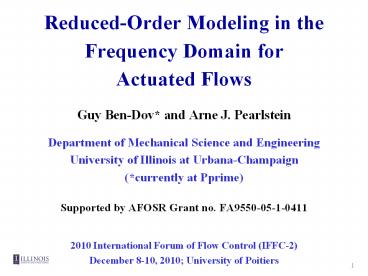Reduced-Order Modeling in the PowerPoint PPT Presentation
1 / 23
Title: Reduced-Order Modeling in the
1
- Reduced-Order Modeling in the
- Frequency Domain for
- Actuated Flows
- Guy Ben-Dov and Arne J. Pearlstein
- Department of Mechanical Science and Engineering
- University of Illinois at Urbana-Champaign
- (currently at Pprime)
- Supported by AFOSR Grant no. FA9550-05-1-0411
- 2010 International Forum of Flow Control (IFFC-2)
- December 8-10, 2010 University of Poitiers
2
Background
Motivation MURI for Airfoil Control by
Synthetic-Jets
Closed-Loop Control of Synthetic-Jets over an
Airfoil Pitch Requires Modeling the Flow as a
Dynamic System Reduced-Order Modeling of
the Governing Flow Equations
Figures by Brzozowski and Glezer (Georgia-Tech)
3
1-D Reduced-Order Modeling Flow Between Two
Parallel Plates
(I)
Exact solution
4
Impulse-Response Flow Between Two Parallel
Plates
Fourier transform of Eq (I) and B.C,
yields
which is sampled for a range of frequencies
5
Reduction of Impulse-ResponseProblem to an ODE
System
- Proper-Orthogonal-Decomposition (POD) in
- Frequency Domain
is the complex conjugate
6
Reduction of Impulse-ResponseProblem to an ODE
System (cont.)
- ODE System Derived from Galerkin Projection of Eq
(I) - onto the POD modes
and the coefficient cN (t) is determined by
imposing u(1,t) F(t) on the upper wall
7
Validation of the ODE SystemVelocity
Reconstructed from 3 POD Modes forArbitrarily
Chosen Forcing Frequency (?04)
Re5
Analytical Solution
Reconstruction from ODE Solution
8
Validation of the ODE SystemVelocity
Reconstructed from 3 POD Modes forArbitrarily
Chosen Forcing Frequency (?04)
Re5
9
Validation of the ODE System for Higher Re?04
and Re50
3 POD modes
5 POD modes
10
2-D Reduced-Order Modeling Linearized
Navier-Stokes Equations
- Objective Develop low-order, real-time
computable ODE models - of the boundary-actuated flow by projecting
solutions of Navier- - Stokes onto a set of orthogonal modes in the
frequency domain.
(I)
(II)
11
Impulse-Response 2-D Linearized Actuated Flow
- With B.C. for Equations (I)-(II),
v- (y) is a given distribution (normal to wall
component) based on the type of actuator
by Fourier transforming, Eqs (I)-(II) are
solved in the frequency domain for a range of
frequencies ?.
12
Reduction of Impulse-ResponseProblem to an ODE
System
- Proper-Orthogonal-Decomposition (POD) in
- Frequency Domain
13
Reduction of Impulse-ResponseProblem to an ODE
System (cont.)
- ODE System Derived from Navier-Stokes Equations
and the coefficients cjM(t) are determined by
projection onto the POD modes ?j(y), and imposing
vin(x0,y,t) v-(y,t) (wall-normal component) at
inlet
14
Reduction of Impulse-ResponseProblem to an ODE
System (cont.)
- Pressure Contribution Computed for Each Mode
using - Poisson Equation for Pressure
15
Model Problem Open-Cavity Flow
- Steady Base-Flow for Re5 (Based on Cavity
Height)
16
Open-Cavity FlowCoordinate Transformation
Streamline/Potential Lines Coordinates
17
Open-Cavity FlowCoordinate Transformation
(cont.)
(
)
The modified N-S Eqs in plane
?
?
,
Project onto the POD modes
where
18
Open-Cavity FlowActuated Flow in the Frequency
Domain
- Injection/Suction Actuation on Upper Part of
Cavity Wall - Flow Fields for ?0
19
Validation of the ODE SystemVelocity
Reconstructed from 9 POD Modes forArbitrarily
Chosen Forcing Frequency (?01)
x-velocity (Re5)
Unsteady Numerical Simulation
Reconstruction from ODE Solution
20
Validation of the ODE SystemVelocity
Reconstructed from 9 POD Modes forArbitrarily
Chosen Forcing Frequency (?01)
y-velocity (Re5)
Reconstruction from ODE Solution
Unsteady NumericalSimulation
21
Validation of the ODE SystemVelocity
Reconstructed from 15 POD Modes forArbitrarily
Chosen Forcing Frequency (?01)
x-velocity (Re50)
Unsteady Numerical Simulation
Reconstruction from ODE Solution
22
Validation of the ODE SystemVelocity
Reconstructed from 15 POD Modes forArbitrarily
Chosen Forcing Frequency (?01)
y-velocity (Re50)
Unsteady Numerical Simulation
Reconstruction from ODE Solution
23
Summary and Conclusions
- A reduced-order-modeling approach has been
proposed for a 1-D model problem governed by a
linear (diffusion) equation. The resulting ODE
system has shown to be valid for time-oscillating
(harmonic) forcing with different frequencies on
one of the boundaries. - A more generalized approach of the
reduced-order-modeling has been proposed to
construct a forced ODE system from the 2-D
linearized Navier-Stokes equations, accounting
for general time-dependent forcing. This approach
may be useful in applications where a given flow
is to be controlled by actuators producing
relatively small changes in the flow-fields. - The proposed approach has been validated on a
model problem of open-cavity flow, controlled by
an injection/suction actuator. The approach can
be easily applied to 3-D flows (since it uses
streamlines, not streamfunction) and for
different types of actuators as well.

